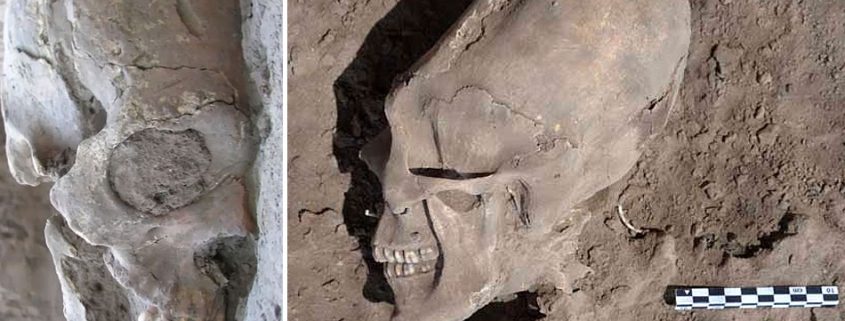Life after Eden must have been a crushing disappointment for early humans, especially the First Couple. Forget about the burden of living under the curse—toiling to coax enough food from the ground to survive, the pain of bringing new life into the world, and all the rest. The realization that they had disappointed their Creator and condemned their children and their children’s children until the end of time to lives apart from Yahweh must have been nearly unbearable.
The Bible gives us very little on the rest of their lives. We only know the names of three of their children: Cain, Abel, and Seth. There must have been others and at least two of them were girls, because Cain and Seth both married and had children of their own. (See? The old question, “Where did Cain find his wife?” isn’t that hard to answer.)
It’s understood that secular archaeologists and historians won’t agree with much of what we believe about human history. That’s okay. We Bible-believing Christians don’t reject science when we interpret data through a biblical lens. Science is the process by which we collect and record information to test theories about the way things are. Analysis is what we do with that information after it’s collected. It’s not the science we often question, it’s the analysis.
Scholars do agree, however, that civilization emerged in the Fertile Crescent around 10,000 B.C. (Note: We’re using dates that are generally accepted by a consensus of scholars so we don’t get bogged down arguing about the timeline. That’s outside the scope of what we’re trying to do here.) Agriculture, cities, writing, trade, science, and organized religion all developed in a broad arc that stretched from Egypt through the Levant and down into Mesopotamia.
This civilization is called the Ubaid culture by scholars. That’s not what the people who lived in it called it, of course; we don’t know what they called themselves because they never invented writing. The Ubaid civilization got its name from Tell al-`Ubaid, a small settlement mound in southeast Iraq where famous archaeologists Henry Hall and Sir Leonard Woolley dug up the first bits of pottery from those people between 1919 and 1924.
 Map of Ubaid civilization sites in Sumer. The first city, Eridu, is on what used to be the shore of the Persian Gulf. (credit John D. Croft / CC-BY-SA-3.0).
Map of Ubaid civilization sites in Sumer. The first city, Eridu, is on what used to be the shore of the Persian Gulf. (credit John D. Croft / CC-BY-SA-3.0).
This happens a lot with prehistoric cultures. The names of their entire civilizations are accidents of discovery, coming from wherever the first archaeologist, bored shepherd, or greedy tomb raider found the first bit of evidence from people we’d never heard of before. Let’s just hope when archaeologists 8,000 years from now discover the remains of our civilization, it’s not by stumbling across the shell of a Wawa or a Piggly Wiggly.
Archaeologists who study the Ubaid culture agree that it spread from Eridu in southeast Iraq, eventually going as far as what is today northwest Iran, northern Syria, southern Turkey, and the Levant (Syria/Lebanon/Jordan/Israel). The Ubaid civilization was typified by large unwalled villages, rectangular multi-room mud-brick houses, high quality pottery, and the first public temples. Crop irrigation developed by about 5000 B.C., so cereals and grains could grow in the dry climate that again dominated the region. The first city in Mesopotamia, and therefore the oldest city in the world, appeared around 5400 B.C. Although agricultural settlements like Jericho (c. 9000 B.C.) and Jarmo, east of modern-day Kirkuk in Iraq (c. 7100 B.C.) are older, Eridu, located in what is today southeastern Iraq, was remembered by later Sumerians as the first city, with a degree of specialization among its citizens not seen before in other settlements.
The Sumerian King List, dated to about 2100 B.C., records it this way:
After the kingship descended from heaven, the kingship was in Eridu. In Eridu, Alulim became king; he ruled for 28,800 years.1
Interestingly, the Bible may support this account.
Cain went away from the presence of the Lord and settled in the land of Nod, east of Eden. Cain knew his wife, and she conceived and bore Enoch. When he built a city, he called the name of the city after the name of his son, Enoch. To Enoch was born Irad, and Irad fathered Mehujael, and Mehujael fathered Methushael, and Methushael fathered Lamech.
Genesis 4:16-18 (ESV), emphasis added
Some scholars, such as Egyptologist David Rohl, believe it’s possible that the “he” in the second sentence refers to Enoch, not Cain. The last word, Enoch, might be a later addition. In that case the builder of the city was Enoch, and the city was named for his son, Irad—hence, Eridu.
To speculate a little further, we can apply a rudimentary translation to the name Alulim and come up with “fourth man” (A = prefix + lu = “man” + lim, a contraction of limmu = “four”). Again, this is speculative and it may be way off base so don’t take it as gospel. But if it’s correct, then Alulim might have been Irad, the “fourth man,” or fourth generation, after creation—Adam, Cain, Enoch, Irad—and the first king of the first city on Earth, Eridu—the city which bore his name.
Regardless of its origins, what is most interesting about Eridu is that besides being the oldest city in Mesopotamia, and possibly the world, is that was also the home of the oldest and largest ziggurat in Mesopotamia. This was the temple of one of the most important gods of the ancient Near East. He was known as Enki to the Sumerians and Ea to the later Akkadians and Babylonians. Enki was the god of the sweet waters needed for life. He was depicted with two streams of water flowing from his shoulders that represented the Tigris and Euphrates rivers, the main sources of fresh water in Mesopotamia.
Along with An (or Anu) the sky god and Enlil, the god of the air, Enki was one of the three most important gods in Sumer. He arrived very early in Sumer from Dilmun, probably the island of Bahrain in the Persian Gulf. In fact, the Sumerians believed Enki personally created Eridu, elevating it from the marshy ground on what was then the shore of the gulf.
Enki was the god of magic, craftsmanship, and wisdom. Although Enlil was the king of the gods, Enki was the keeper of the mes (sounds like “mezz”), decrees of the gods that formed the fundamental concepts and gifts of civilization—everything from religious practices to social interaction to music.
The Babylonian creation myth, the Enuma Elish, describes how everything on Earth came into being through the defeat of the chaos goddess Tiamat by Marduk, son of Enki/Ea, the chief god of Babylon. However, the older Sumerian story credits Enki with giving life to all things, including mankind, and names Enlil the slayer of Tiamat.
The differences in the story are at least partly due to the ebb and flow of power over the centuries. Each city in Mesopotamia had a patron god or goddess. The importance of a deity was, as you’d guess, tied to the fortunes of its city. Just as Eridu was the home of Enki, Enlil was chief deity at Nippur, Inanna (Ishtar) was supreme at Uruk, the sun god Utu was the patron deity of Sippar, and so on. To give you an idea of the incredible amount of time we’re dealing with, Enki ruled in Eridu for about 3,500 years before Marduk replaced Enlil at the head of the Mesopotamian pantheon, an event linked to Babylon’s emergence as the region’s dominant power in the 18th century B.C.
That’s about the same amount of time that’s passed between Moses leading the Israelites out of Egypt and you reading this sentence.
This essay is not in any way a thorough review of life, culture, or religion in ancient Mesopotamia, but there is one more aspect of life in the ancient Near East to call to your attention. It’s something we usually only hear about from fringe pseudo-scholars who blame the phenomenon on extraterrestrials. Scholars—archaeologists and sociologists—have known at least since the late 1940s that people throughout Mesopotamia, before they learned how to write, figured out how to turn their children into coneheads.
It appears, based on human remains dated to between about 10,000 B.C. and 3500 B.C., that cranial deformation was widespread in the Ubaid culture, and Eridu—the world’s first city, possibly built by Cain or his son—was Ground Zero for head shaping. An archaeological dig at Eridu just after World War II discovered about a thousand bodies that were buried during the Ubaid. Of the 206 sets of remains the archaeologists exhumed, “all of the crania had been deformed in one fashion or another.”2
Got that? 206 out of 206. Not a few, and not just the elites. It appears that everybody from every strata of the Eridu culture had a deformed skull.
 Deformed crania from the Ubaid culture site at Seyh Höyük in Turkey (photo by Kirsi O. Lorentz).
Deformed crania from the Ubaid culture site at Seyh Höyük in Turkey (photo by Kirsi O. Lorentz).
Now, instead of asking why, the lead archaeologist decided “earth pressure” after burial was the cause2—even though none of the skulls were cracked or broken, which would be expected if the deformations had occurred after death.
Evidence of head shaping has been found at sites all over Iraq, southwestern Iran, eastern Turkey, the valleys of the Zagros mountains, and the western shores of the Persian Gulf, dated from 7500 B.C. to about 4000 B.C. After that, the practice seems to disappear.
Hmm. If we place a global flood sometime between 4000 and 3500 B.C….
1 Black, J.A., Cunningham, G., Fluckiger-Hawker, E, Robson, E., and Zólyomi, G. “The Sumerian King List: Translation,” The Electronic Text Corpus of Sumerian Literature (http://etcsl.orinst.ox.ac.uk/section2/tr211.htm), retrieved 12/24/16.
2 Coon, C.S. “The Eridu Crania: A Preliminary Report,” Sumer 5, 1949, p 103.
To go much deeper with author and Biblical History Researcher Derek Gilbert read his recent book “The Great Inception”

Derek Gilbert Bio
Derek P. Gilbert hosts SkyWatchTV, a Christian television program that airs on several national networks, the long-running interview podcast A View from the Bunker, and co-hosts SciFriday, a weekly television program that analyzes science news with his wife, author Sharon K. Gilbert.
Before joining SkyWatchTV in 2015, his secular broadcasting career spanned more than 25 years with stops at radio stations in Philadelphia, Saint Louis, Little Rock, and suburban Chicago.
Derek is a Christian, a husband and a father. He’s been a regular speaker at Bible prophecy conferences in recent years. Derek’s most recent book is The Great Inception: Satan’s PSYOPs from Eden to Armageddon. He has also published the novels The God Conspiracy and Iron Dragons, and he’s a contributing author to the nonfiction anthologies God’s Ghostbusters, Blood on the Altar, I Predict: What 12 Global Experts Believe You Will See by 2025, and When Once We Were a Nation.





Leave a Reply
Want to join the discussion?Feel free to contribute!